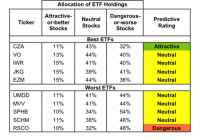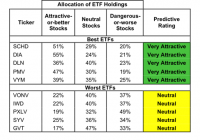Q4 2015 Investment Style Ratings For ETFs And Mutual Funds
Summary Our style ratings are based on the aggregation of our fund ratings for every ETF and mutual fund in each style. The primary driver behind an Attractive fund rating is good portfolio management (stock picking) combined with low total annual costs. Cheap funds can dupe investors and investors should invest only in funds with good stocks and low fees. At the beginning of the fourth quarter of 2015, only the Large Cap Value and Large Cap Blend styles earn an Attractive-or-better rating. Our style ratings are based on the aggregation of our fund ratings for every ETF and mutual fund in each style. See last quarter’s Style Ratings here. Investors looking for style funds that hold quality stocks should look no further than the Large Cap Blend and Large Cap Value styles. Not only do these styles receive our Attractive rating, they also house the most Attractive-or-better rated funds. Figures 4 through 7 provide more details. The primary driver behind an Attractive fund rating is good portfolio management , or good stock picking, with low total annual costs . Attractive-or-better ratings do not always correlate with Attractive-or-better total annual costs. This fact underscores that (1) cheap funds can dupe investors and (2) investors should invest only in funds with good stocks and low fees. See Figures 4 through 13 for a detailed breakdown of ratings distributions by investment style. All of our reports on the best & worst ETFs and mutual funds in every investment style are available here . Figure 1: Ratings For All Investment Styles (click to enlarge) To earn an Attractive-or-better Predictive Rating, an ETF or mutual fund must have high-quality holdings and low costs. Only the top 30% of all ETFs and mutual funds earn our Attractive or better rating. The State Street SPDR Dow Jones Industrial Average ETF (NYSEARCA: DIA ) is the top rated Large Cap Value fund. It gets our Very Attractive rating by allocating over 51% of its value to Attractive-or-better-rated stocks. International Business Machines (NYSE: IBM ) is one of our favorite stocks held by DIA and receives our Attractive rating. Over the last decade, IBM has grown after-tax profit (NOPAT) by 8% compounded annually while doubling NOPAT margins. In addition to strong NOPAT growth, IBM has improved its return on invested capital ( ROIC ) to 12%, from 9% in 2005. Despite the strength in its business, IBM shares remain undervalued. At its current price of $140/share, IBM has a price to economic book value ratio ( PEBV ) of 0.8. This ratio implies that the market expects IBM’s NOPAT to permanently decline by 20%. Even if IBM can only grow NOPAT by 2% compounded annually for the next five years , the stock is worth $211/share today – a 51% upside. The ProFunds Small Cap Fund (MUTF: SLPSX ) is the worst rated Small Cap Blend fund and overall worst-rated style mutual fund. It gets our Very Dangerous rating by allocating 20% of its value to Dangerous-or-worse-rated stocks and 60% held in cash. Making matters worse, it charges investors total annual costs of 5.50%. Why should investors pay such high fees when over half their assets are held in cash? Denny’s Corporation (NASDAQ: DENN ) is one of our least favorite stocks held by Small Cap ETFs and mutual funds and earns our Dangerous rating. Over the last five years, the company’s NOPAT has declined by 7% compounded annually. The company currently earns a 6% ROIC. Despite declining profits, DENN has soared over the past five years and shares are up nearly 250%. This price appreciation has left DENN significantly overvalued. To justify its current price of $11/share, Denny’s must grow NOPAT by 10% compounded annually for the next 15 years . This expectation seems rather optimistic given Denny’s failure to grow profits over the past five years. Figure 2 shows the distribution of our Predictive Ratings for all investment style ETFs and mutual funds. Figure 2: Distribution of ETFs & Mutual Funds (Assets and Count) by Predictive Rating (click to enlarge) Figure 3 offers additional details on the quality of the investment style funds. Note that the average total annual cost of Very Dangerous funds is almost four times that of Very Attractive funds. Figure 3: Predictive Rating Distribution Stats (click to enlarge) * Avg TAC = Weighted Average Total Annual Costs This table shows that only the best of the best funds get our Very Attractive Rating: they must hold good stocks AND have low costs. Investors deserve to have the best of both and we are here to give it to them. Ratings by Investment Style Figure 4 presents a mapping of Very Attractive funds by investment style. The chart shows the number of Very Attractive funds in each investment style and the percentage of assets in each style allocated to funds that are rated Very Attractive. Figure 4: Very Attractive ETFs & Mutual Funds by Investment Style (click to enlarge) Figure 5 presents the data charted in Figure 4 Figure 5: Very Attractive ETFs & Mutual Funds by Investment Style (click to enlarge) Figure 6 presents a mapping of Attractive funds by investment style. The chart shows the number of Attractive funds in each style and the percentage of assets allocated to Attractive-rated funds in each style. Figure 6: Attractive ETFs & Mutual Funds by Investment Style (click to enlarge) Figure 7 presents the data charted in Figure 6. Figure 7: Attractive ETFs & Mutual Funds by Investment Style (click to enlarge) Figure 8 presents a mapping of Neutral funds by investment style. The chart shows the number of Neutral funds in each investment style and the percentage of assets allocated to Neutral-rated funds in each style. Figure 8: Neutral ETFs & Mutual Funds by Investment Style (click to enlarge) Figure 9 presents the data charted in Figure 8. Figure 9: Neutral ETFs & Mutual Funds by Investment Style (click to enlarge) Figure 10 presents a mapping of Dangerous funds by fund style. The chart shows the number of Dangerous funds in each investment style and the percentage of assets allocated to Dangerous-rated funds in each style. The landscape of style ETFs and mutual funds is littered with Dangerous funds. Investors in Small Cap Blend funds have put over 57% of their assets in Dangerous-rated funds. Figure 10: Dangerous ETFs & Mutual Funds by Investment Style (click to enlarge) Figure 11 presents the data charted in Figure 10. Figure 11: Dangerous ETFs & Mutual Funds by Investment Style (click to enlarge) Figure 12 presents a mapping of Very Dangerous funds by fund style. The chart shows the number of Very Dangerous funds in each investment style and the percentage of assets in each style allocated to funds that are rated Very Dangerous. Figure 12: Very Dangerous ETFs & Mutual Funds by Investment Style (click to enlarge) Figure 13 presents the data charted in Figure 12. Figure 13: Very Dangerous ETFs & Mutual Funds by Investment Style (click to enlarge) Source Figures 1-13: New Constructs, LLC and company filings D isclosure: David Trainer and Thaxston McKee receive no compensation to write about any specific stock, sector or theme.

